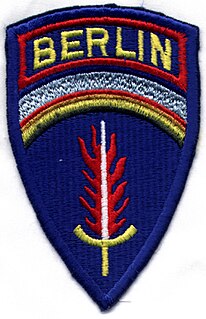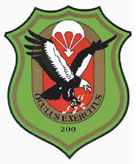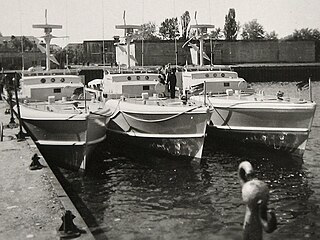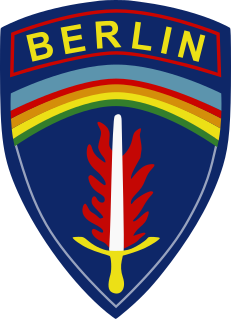 W
WThe 6th Separate Guards Motor Rifle Brigade was a Soviet Army mechanized infantry brigade, stationed in East Berlin during the Cold War, from 1962 to 1989.
 W
WThe Berlin Brigade was a US Army brigade-sized garrison based in West Berlin during the Cold War. After the end of World War II, under the conditions of the Yalta and Potsdam agreements, the Allied forces occupied West Berlin. This occupation lasted throughout the Cold War. The French Army also had units in Berlin, called Forces Françaises à Berlin and the British Army's unit in Berlin was the Berlin Infantry Brigade.
 W
WThe Berlin Infantry Brigade was a British Army brigade-sized garrison based in West Berlin during the Cold War. After the end of World War II, under the conditions of the Yalta and Potsdam agreements, the Allied forces occupied West Berlin. This occupation lasted throughout the Cold War. The French Army also had units in Berlin, called Forces Françaises à Berlin and the US Army's unit in Berlin was the Berlin Brigade.
 W
WThe 1961 F-84 Thunderstreak incident, occurring on 14 September 1961, was an incident during the Cold War, in which two Republic F-84F Thunderstreak fighter-bombers of JaBoG 32 of the German Air Force (Luftwaffe) crossed into East German airspace because of a navigational error, before landing at Berlin Tegel Airport. The two planes successfully evaded a large number of Soviet fighter planes by finding cover in a heavy layer of clouds, but also by the actions of an airman at the United States Air Force air route traffic control center at Berlin Tempelhof Airport who ordered the planes on to Berlin rather than forcing them to turn around and face the pursuing fighter planes. The event came at a historically difficult time in relations between the two Germanies. Only a month before, the Berlin Wall had been built, which completely cut off West Berlin from surrounding East Germany and from East Berlin. It also came three days before the West German federal election, held on 17 September 1961.
 W
WThe FSLK200 was a highly specialized reconnaissance unit of the German Armed Forces (Bundeswehr). It has also been described as a deep reconnaissance company.
 W
WThe Fulda Gap, an area between the Hesse-Thuringian border and Frankfurt am Main, contains two corridors of lowlands through which tanks might have driven in a surprise attack by the Soviets and their Warsaw Pact allies to gain crossing(s) of the Rhine River. Named for the town of Fulda, the Fulda Gap became seen as strategically important during the Cold War of 1947–1991. The Fulda Gap roughly corresponds to the route along which Napoleon chose to withdraw his armies after defeat at the Battle of Leipzig. Napoleon succeeded in defeating a Bavarian-Austrian army under Wrede in the Battle of Hanau not far from Frankfurt; from there he escaped back to France.
 W
WThe Western Group of Forces (WGF), previously known as the Group of Soviet Occupation Forces in Germany (GSOFG) and the Group of Soviet Forces in Germany (GSFG), were the troops of the Soviet Army in East Germany. The Group of Soviet Occupation Forces in Germany was formed after the end of World War II in Europe from units of the 1st and 2nd Belorussian Fronts. The group helped suppress the East German uprising of 1953. After the end of occupation functions in 1954 the group was renamed the Group of Soviet Forces in Germany. The group represented Soviet interests in East Germany during the Cold War. After changes in Soviet foreign policy during the late 1980s, the group shifted to a more defensive role and in 1988 became the Western Group of Forces. Russian forces remained in the eastern part of Germany after the dissolution of the Soviet Union and the German reunification until 1994.
 W
WOperation Jungle was a programme by the British Secret Intelligence Service (MI6) early in the Cold War from 1949 to 1955 for the clandestine insertion of intelligence and resistance agents into Poland and the Baltic states. The agents were mostly Polish, Estonian, Latvian and Lithuanian exiles who had been trained in the United Kingdom and Sweden and were to link up with the anti-Soviet resistance against the communist governments. The naval operations of the programme were carried out by German crew-members of the German Mine Sweeping Administration under the control of the Royal Navy. The American-sponsored Gehlen Organization also got involved in the draft of agents from Eastern Europe. However, the MGB penetrated the network and captured or turned most of the agents.
 W
WU.S. Army Berlin (USAB) was a command of the United States Army created in December 1961 at the height of the Berlin Wall crisis. USAB was a combined command with the Headquarters, U.S. Command Berlin (USCOB). This combined organization was sometimes called the "Berlin Command". USCOB/USAB was a separate command from the U.S. Army Europe (USAREUR) which had previously been in command of American troops in West Berlin.